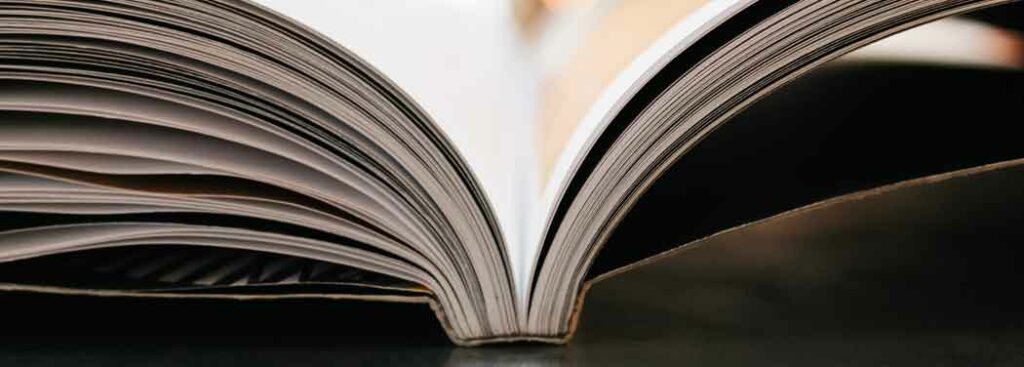How to Format a Manuscript Like A Pro (A Guide for Nonfiction Writers)

As a nonfiction writer, learning how to format a manuscript properly will save you a lot of heartache and, yes, a lot of money too. Let’s look into why this is. As a nonfiction author, your credibility and your reputation will hang on the execution of your book. This includes not only your use of grammar and your choice of words but also the overall aesthetic of your final product.
For example, the use of a stylized font type in your book may give your readers the perception that you’re not taking the subject matter seriously and an amateurish-looking layout may impact your credibility, even if your book’s information is ground-breaking.
A nonfiction book projects the author’s reputation, credibility and trustworthiness – you wouldn’t trust a law firm where the attorney greets you wearing ripped jeans and sandals, would you? So, as a nonfiction author it’s imperative that you hire professionals to both design your book as well as to edit the text in your manuscript.
Now, in order for these professionals to be able to their jobs, you need to learn how to format your manuscript like a pro before you hand it over to them.
I’ve written this article to teach you the rules you need to follow to format a manuscript in the same way that professional authors do, in order to make things easier for your book editor and designer so they can focus on what they do best.
How to Format Your Manuscript for the Nonfiction Genre
There are six key steps that professional writers employ before they start typing. Follow the steps below and you’ll be doing your editor and your book designer a great service:
Formatting Step 1: Text
Most of us learned to use word processors to write minimally formatted text, such as emails, business letters, notes, etc.
When I say minimally formatted I mean that in addition to typing the text, at most we’ll use the return key to go to the next line and maybe the tab key here and there, but that’s about it. To create extra white space, we’ll likely hit the return key several times and some of us will use a double space between sentences.
While these habits are harmless in most of our daily writing tasks, they can cause havoc for editors and designers when they work on your manuscript document. Avoid accidentally doing these things by following the best manuscript formatting practices below:
Line Spacing
Always use a line spacing of either 1.5 lines or double space lines (don’t use a single space). You’ll find this setting in most word processors by opening the paragraph-formatting menu. This line spacing will make your manuscript easy to read for your editor.
Font Type and Font Size
Choose Times New Roman as your font type and choose a text size of 12 points. You want to do this for the sake of your editor’s sight! Font sizes that are smaller than 12 are hard to read on most computer screens, and sizes larger than 12 are unnecessary.
Paragraphs

The optimal paragraph setting for nonfiction manuscripts is to use a first-line indentation of 0.25 inches with no spacing between paragraphs. This indentation indicates to your editor where new paragraphs begin in the document. Using no indentation can sometimes make it difficult to figure where one paragraph ends and the next one begins.
Also, ensure that your text is always left justified for all manuscript submissions. Any other type of paragraph formatting – such as full text justification, block paragraphs with spacing between them and other layout tricks – will be applied later by your book designer in the post-production stage.
Use of Paragraph Breaks
Only use a single paragraph break (i.e. hitting the return key) after you finish typing a paragraph – never use repeated breaks to create extra spaces because it’ll make the life of your book designer miserable!
If you want to have extra white lines or other design elements after the end of paragraphs, the correct way to go is to note them in the manuscript with instructions that read “(white lines go here)” or “(line with a decorative ornament or pictograph goes here)”.
Use of Space Bar
Always use a single space to separate words or sentences. Never use double spaces or the tab key (this includes not using two spaces after a period as a way to separate sentences). Also, never use multiple spaces to create white space.
If you have the need to include a lot of empty space in front of some words in a paragraph for a specific reason, then make a note in brackets for your designer with your requirements and include it in your manuscript.
Chapter Breaks
This is a critical piece of formatting. When you finish typing the last paragraph in a chapter, never hit the return key multiple times in order to get to a blank page.
Just type the title of the upcoming chapter in a new paragraph and then set a “page break.” In most word processors, you’ll be able to access this setting in the paragraph-formatting menu.
Formatting Step 2: Images/Charts/Tables

Never embed images in your manuscript. Always indicate where the image goes with instructions in brackets that look like this:
(Image file: chapter-three-image-four-green-flowchart.jpg, Caption: This flowchart depicts X, Y or Z, Special instructions: right-justify image so text flows to its left and ends right above the beginning of the heading text in chapter four).
Then, supply your editor and book designer with a memory stick with the image files sorted alphabetically.
Formatting Step 3: Headings
When you start a new chapter, type your chapter name in a new line and then go to the Styles menu and choose Heading 1. Whenever you enter sub-chapters name make them Heading 2. If you have sub-sub-chapters make them Heading 3, and so on.
This is important for your book designer because chapter and sub-chapter titles are typically formatted with a bigger size font and often with a different font type. Also, this will allow your designer to auto-generate your book’s table of contents.
Formatting Step 4: Page Number and Chapter Number
Before you hand over your completed manuscript to your editor, make sure that you add page numbers. This is an automated function that can be added by inserting a footer in your document. Instructions on how to do this will vary for each word processing app, but there are plenty of resources on the web on how to do this.
Also, make sure you add a chapter number for each new chapter in your book and a section or part number if you’re grouping chapters thematically.
Formatting Step 5: Title Page
At the beginning of your manuscript document, editors require that you include a title page that contains your book’s title and subtitle starting on the top left hand side, followed by your author name or pen name, the total word count from your word processor, and your contact information including your phone number and your email address.
Formatting Step 6: Manuscript File
Finally, always submit formatted manuscripts as a single file, not as separate chapter files.
Don’t worry about adding any front matter (e.g. copyright page, dedication page, acknowledgments, foreword, etc.) or back matter (about the author, index, list of references, etc.) at this point, as this information will be created in the post-production process.
Your editor will eventually have a look at any front and back matter that needs to be edited after your manuscript is publication ready. Note that your book’s introduction is part of the body of your book, not the front matter, so this is something that needs to be included in the manuscript right before your first chapter.
Also, don’t worry about adding a header to your formatted manuscript containing your book title, chapter titles and so on, since this is also something that is added by your book designer in post-production.
Next Steps
Follow the above standard manuscript format rules and you’ll make things much easier for the editors and designers who will be taking your writing project to the next level, as they’ll be able to concentrate on their jobs without having to spend any time doing unnecessary clean-up work.
If you’d like to learn more about book formatting to be familiar with the elements that your book designer will be working with, read 10 Nonfiction Book Layout Tips That Will Glue Your Audience to the Page.
If you enjoyed this article and are in the process of writing, designing or publishing a nonfiction book, be sure to check out my free nonfiction success guide, drawn from years of experience editing books for bestselling authors (including a New York Times bestseller) and ghostwriting for CEOs and politicians. Simply click here to get instant access.
Ben
Leave me a comment below if you have any questions or a specific need that I can help you address – I operate an author services firm that specializes in helping entrepreneurs, professionals and business owners who want to publish books as a calling card for prospects, to establish their status as an expert or to just to generate additional leads for their businesses.
Here are some related articles I highly recommend:
How to Become a Great Book Writer in Business Nonfiction
The 7 Key Rules for Writers of Outstanding Nonfiction Books
 Bennett R. Coles is an award-winning author of six books published through Harper Collins (New York) and Titan Publishing Group (London). He is also the publisher at Promontory Press, editor for multiple bestselling authors (including a NY Times bestseller), ghostwriter for CEOs and politicians and the founder of Cascadia Author Services, a boutique full-service firm that specializes in premium author services specifically designed for busy professionals. Our end-to-end services include writers coaching, ghostwriting, developmental editing, copy editing proofreading, cover design, book text layout, eBook production, marketing, printing and distribution.
Bennett R. Coles is an award-winning author of six books published through Harper Collins (New York) and Titan Publishing Group (London). He is also the publisher at Promontory Press, editor for multiple bestselling authors (including a NY Times bestseller), ghostwriter for CEOs and politicians and the founder of Cascadia Author Services, a boutique full-service firm that specializes in premium author services specifically designed for busy professionals. Our end-to-end services include writers coaching, ghostwriting, developmental editing, copy editing proofreading, cover design, book text layout, eBook production, marketing, printing and distribution.
6 responses to “How to Format a Manuscript Like A Pro (A Guide for Nonfiction Writers)”
-

I am writing my first book and I decided to self-publish which I’m finding out is very challenging but fun. This was very informative and helped a great deal. Thanks Bennett
-

Hi Brenda, I am writing my first non-fiction book as well. I was curious as to your experience was in self-publishing; cost, difficulty, time and arrangements; any suggestions.
Thank you so much for your time.
Skip McCloskey
-
-

Your much needed advice kept me off the road, iam 89, and I didn’t have to drive 35 miles to Barnes n Noble .
I have a Children’s story I wrote in the late 60’s and was not accepted, so iam trying now to get it published.
Respectfully, Ron Hank Sward -

I am confused about line spacing related to illustrations. Can I single space to keep the information where it belongs to inform about the drawing? New author and just Learning. I did double space most of the information
In the manuscript. Great information.-

Hi Carol, keep in mind when your book is typeset for print, it will look different than it does in your word processor. We suggest keeping all the line spacing 1.5 or double spaced to make it easier to be edited and professionally typeset.
-
-

I did not tell you the book I am writing is a nonfiction how to guide about designing and sewing draperies. I am the illustrator and it is 292 pages long with over 150 simple illustrations.







Leave a Reply